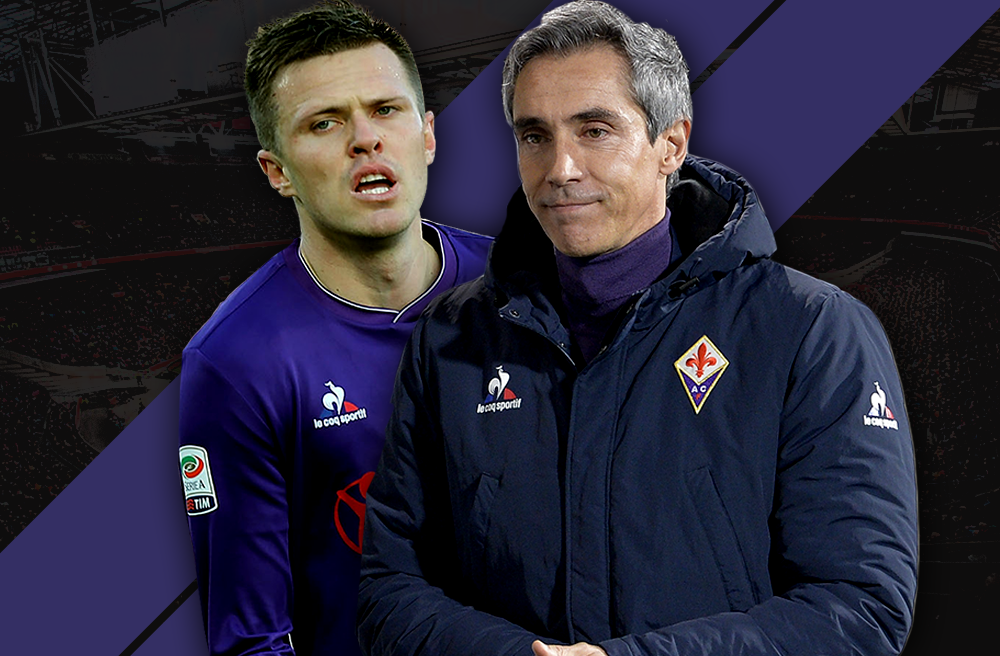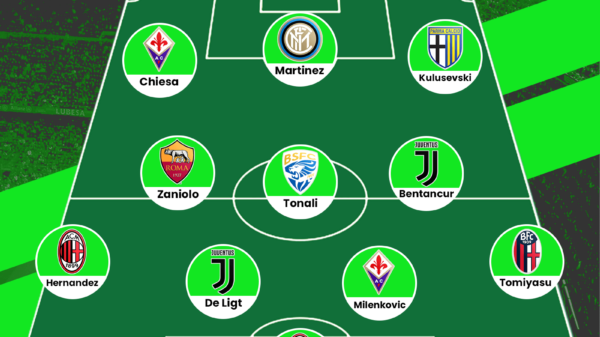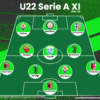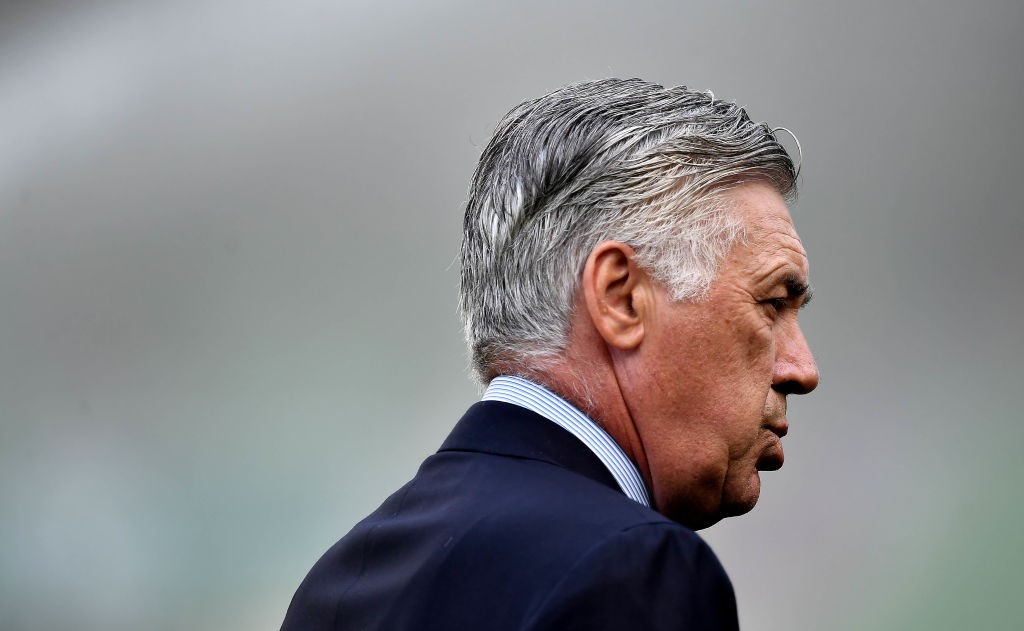
Being a football hipster is serious business with knowledge about the young starlet making waves for a non-mainstream mid table side often a prerequisite rather than a feather in the cap. To further enhance your, perhaps, burgeoning reputation as a true hipster, Outside of the Boot is on hand to provide an in-depth guide to some of the less celebrated teams around Europe. In this edition of the series, Nachiketh Ramesh has a look at Fiorentina.

THE PREVIOUS CAMPAIGN
Florence, built during the early part of the Roman Empire, was the epicenter of the cultural and scientific revolution of 15th Century that spread across Europe and came to be known as the Renaissance. The city is an exhibition of sculptures of the Renaissance period and shows how rich it’s culture and heritage is. ACF Fiorentina, to match and resonate with these historically important factors that make the city so beautiful, deserves football to be played in a similar manner– the style that mesmerizes and inspires thousands of people.
When Vincenzo Montella left the club many pondered over one question whether La Viola could ever find a coach who envisions aesthetically pleasing football. In the post-Montella era of the club, Paulo Sousa has delivered just the same so far. During Montella’s period, Fiorentina finished fourth in Serie A for three consecutive seasons. In Montella’s final season in Florence, the club reached the zenith under him – performing well in Europe and falling short in the penultimate step of Europa League.
Last season, under Sousa, Fiorentina slipped one position down in the final league table and finished fifth. In contrast to the final standings of the past seasons, it is a downgrade. But in terms of the performances on the field, there were some really good moments.
MANAGER PROFILE
Sousa had an overwhelming career as a football player, playing for the top teams of Europe’s best leagues and crowning his career by winning a Champions League title with Juventus and Borussia Dortmund in the process. With a bunch of medals in his bag, Sousa set out to be a coach and started to build his stature. His first stint was with the London club Queens Park Rangers. This was followed by a year at Swansea and a few months at Leicester.
Sousa’s philosophy of football is to have the ball, dominate the opposition, open space and create chances. In a land where directness in attack and retreat defending is still considered to be the best way of playing, Sousa’s talents remained hidden. He needed some freedom and some space to express himself. Videoton in Hungary acted host to him as he set his playing principle to action. Success in Hungary attracted Maccabi-Tel-Aviv’s attention, where the Portuguese manager won the league title in his debut season. FC Basel sought out Sousa’s service, which prompted him to move his base from Israel to Switzerland. At Basel too, Sousa proved to be a lucky charm for the club – he won the Swiss Super League! His next stop was Florence, Italy.
Like a pro gamer unlocking achievements one after another, Sousa moved higher up the order from Hungary to Italy, winning championships and earning fame. Having displayed an attractive and effective style of play leading to a string of good seasons, there was no point in doubting Fiorentina’s desire when Sousa was appointed. The club needed a clear shot at the title and wanted to do so in style.
TACTICAL APPROACH
Sousa believes in ball possession with effective positioning to make openings for the creation of chances. Teams are usually fielded in a 4-2-3-1 formation which changes to 3-4-2-1 or 3-2-4-1 while in possession. The right back moves inwards to the center and the two center backs shift towards the left, changing from a back four to back three. The winger provides the width on the right side. The left wingback provides the width on the left side of the field. This enables the left winger to move towards the center. By changing the shape, Fiorentina players present themselves with a chance to occupy all the needed zones for launching a perfect attack involving a lot of ball circulation through the opposition.

The winger moving towards the half-space presents Fiorentina with two #10s and creates a rough rhombus between the four midfielders. This allows the ball to progress from the back to the front through the center of the field. If the opponents decide to stay compact, the Florentine’s advanced wide players help in stretching the defense and provide good crosses for the likes of Nikola Kalininc and Josip Ilicic to connect to.
In the defensive phase of the game, Fiorentina tries to remain as compact as possible and overload the central zones. Fiorentina players form a tight band of five players in the middle and deny ball penetration for the opponents. Also through the usage of cover shadows, they block the free spaces. The players make sure to position themselves in the half-spaces to prevent the opposition from having a free player there.

The narrow defensive shape of Fiorentina forces attacking teams to wide regions. The band in the middle denies ball progression.
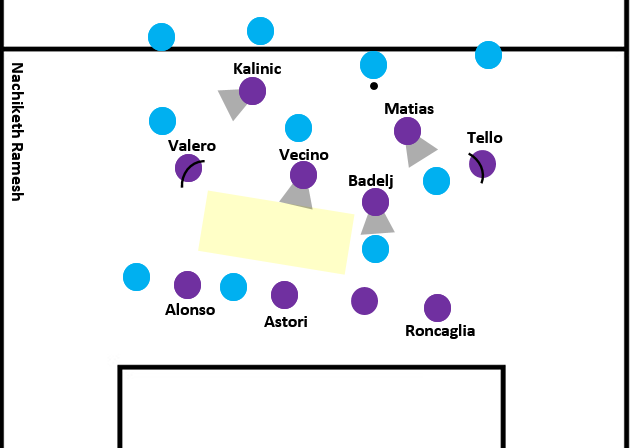
Players using cover shadows to block access to half-space and the free space in front of the defenders.
When the opponents move the ball to the half-space, Fiorentina players just slide towards the ball and press through the near side #10. If the ball is moved to the wing, then the wingback presses the ball and the near side center back covers for him. Depending on the movement of the wide player on the far side, the team varies between a back five and four. Fiorentina, staying compactly layered in the middle, deny the defenders the passing lanes to their midfielders.
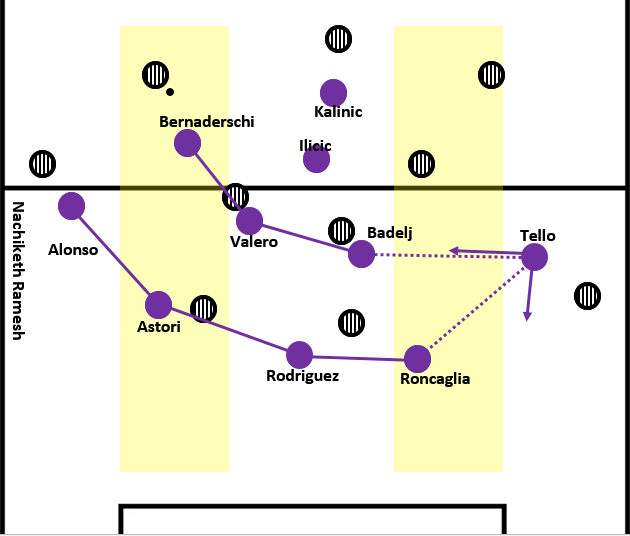
Fiorentina shifting to defend when the opponents have the ball in the half-space during build-ups.
One of the major concerns is when the opponents break into the final third and do so by maintaining multiple width options on the ball near side. This forces Fiorentina to move out towards the ball and leave far side half-space open. If an opponent positions deep in the half-space, then the wide players gets confused – whether to follow the player and be narrow or leave him be and stay wide.

Near side half-space open as Alli influences Kuba’s positioning.

Central area open. One of the main problems for Fiorentina when clubs penerate into the final third.
Situations like these need to be avoided if Sousa aims for the higher position in the table and a better showing in Europe.
TRANSFER MARKET ACTIVITY
Apart from Facundo Roncaglia leaving and Davide Astori becoming a permanent part of the team, all other dealings have involved players aged 20 or under. Bartlomiej Dragowski, Hernan Toledo, Ianis Hagi, and Kevin Diks have been signed from clubs across Europe.
THREE KEY PLAYERS
Nikola Kalinic: Leading the attacks from the front and being the attacking spearhead, Kalinic is the main goal threat posed by Fiorentina. Talking about Kalinic’s actions with the ball, he can sense the movements of his teammates while receiving the ball. He has the ability to hold up the ball, shield it from the pressing opponent and dribble out of pressure. By doing so, Kalinic opens space behind the pressing line for his teammates to run into. He is also equally adept at dropping into midfield and allows the players around him to storm towards the opposition goal. In terms of the attacking threat, Kalinic is lethal inside the box and enjoys linking up with wide players and being at the receiving end of the cross. Most of his goals for Fiorentina last season were assisted from the wide zones. His decent first touch and above average ball control allow him to evade pressure in the middle and be very productive in front of the goal.
If Fiorentina aims to challenge for a Champions League position, the Kalinic must find the back of the net more often than last season, in which he scored 12 times. Even with Mauro Zarate, Mario Gomez, and Giuseppe Rossi in contention for the striker’s place, Kalinic must still be the first choice.
Borja Valero: Valero is the heart of Sousa playing system. The Spanish midfielder can play as a #8 and even shift up the pitch to be the central attacking midfielder. In his four-year stay at Fiorentina, Valero has averaged 87.98% pass success rate and has kept the team ticking closer the goal – picking the right pass to find his teammates. His movements with the ball help him in being resistant to pressing by opponents. In a setup with a strong defensive midfielder by his side and with more creative freedom, Valero can be a good central midfield option.
Davide Astori: AC Milan’s youth product, Astori spent last season in Florence coming on loan from Cagliari. Impressed with his performances under Sousa, Fiorentina has bought him from his parent club. Astori plays as the left center back in back four and back three systems used by his manager. His ball playing ability makes him a valuable player for Sousa. Last season he completed 70.5 passes at a rate of 88.7 passes complete percentage. Since Astori can play decent long diagonal balls to the players on the wings, he can be used as the long passing option when pressed by opponents. His shielding of the ball in the close presence of opponents helps him being in soaking the pressure and moving the ball to the free player. One of his main traits is his tendency to move higher up the pitch with the ball and make his presence felt in the lower middle third of the field. With an average of 3 passing interceptions per game, Astori helps Fiorentina in regaining the ball and restarting the play.
TALENT RADAR KEY YOUNG PLAYER
Kevin Diks, previously of Vitesse Arnhem in the Netherlands, was brought by Fiorentina a month ago. Since Roncaglia has left for the La Liga side Celta Vigo we might see Diks in action this season itself. I have my reasons for considering him ahead of Hagi, Toledo, and Dragowski, but it is worthwhile keeping an eye on these players and at the same time playing extra attention to Diks.
Diks plays at right back and has the characteristics of an attacking wingback. His speed is excellent while his passing is also good. He likes to cut into the center and involve more in the game. His ability to constantly shuttle between and play in the half-space and wing might prompt Sousa to play Diks as right back – changing slowly to back three. This could also open up opportunities in terms of Diks underlapping the wide player and dribbling through the half-space while the side is changing back to 4-2-3-1 from 3-2-4-1. He faces stiff competition from Gilberto and Nenad Tomovic.
CONCLUSION AND EXPECTATION
Last year was Sousa’s first season at Florence. It was the time of adjusting to the new environment and players. However, we witnessed some good football from Fiorentina and it was really hard on the team as it finished fifth. Draws against weaker teams and some defeats against the top four teams denied Fiorentina’s manager a good ending to the season.
Sousa has not made any major changes to the squad apart from letting Roncaglia go. He has brought in a few talented youngsters – maybe in the hope of fusing them into the first team. With everything in place by now, we can expect Fiorentina to pose a greater challenge than last year and aim for a silverware.
Read all our 2016-17 Hipster Guide articles here
- Hipster Guide 2016-17: Fiorentina’s tactics, key players and emerging talents - August 17, 2016
- Euro 2016 Tactical Analysis: Germany 1–1 Italy (6-5 Pens) | Germany and Italy play almost similar systems - July 5, 2016
- Euro 2016 Tactical Analysis: England 1 – 2 Iceland | Tactically disciplined Iceland kicks England out of Europe. - June 29, 2016




















































